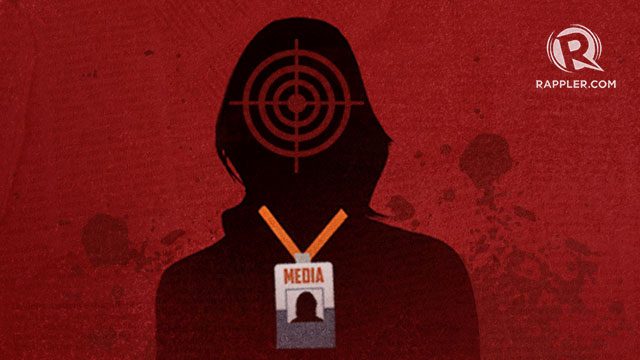SUMMARY
This is AI generated summarization, which may have errors. For context, always refer to the full article.
![[OPINION | Newspoint] A dangerous place](https://www.rappler.com/tachyon/r3-assets/612F469A6EA84F6BAE882D2B94A4B421/img/30AA0A58E1E54C108858A7A47215632C/vergel-santos-headshot-150px.jpg)
The international organization Reporters Without Borders has rated the Philippines as the most dangerous place for journalists in Asia and among the 5 most dangerous in the world. No one would quarrel with that. In fact, the Philippines has lingered around those levels of notoriety through the years.
Journalists being democracy’s designated frontliners for unearthing and exposing official wrongdoing, their safety is naturally a critical concern. But, lest the forest be missed for the trees, the Philippines is actually one of the world’s most dangerous places not just for journalists but for its very own people. A survey of presidential history illuminates the point.
The excuse is not seldom given that the Filipino people are a condemned child of history; the fact is they have been victims of a run of corrupt and high-handed leaders that began with Ferdinand Marcos.
Through 14 years of martial law, from 1972, Marcos racked up a formidable record of murder, torture, enforced disappearances, and plunder. The great flush of popular revolt by street vigil in 1986 did succeed in sweeping him out of power, bloodlessly, and in installing a democratic successor, but it failed to stop a rebound of reactionary forces.
Already saddled with a plundered and debt-ridden economy and a damaged culture, Corazon Aquino had yet to fight off 7 coup plots. That she managed under those conditions to get a constitutional democracy reestablished was achievement enough: it provided her successor and revolt partner, Fidel Ramos, with an institutional framework for socioeconomic reconstruction.
Doubtless helped by being once a Marcos general, Ramos himself served out a coup-free term and responded with a productive leadership. But, after him, the nation, under Joseph Estrada, went backsliding so dramatically he had to be stopped in midterm; he was impeached for plunder and, when the senators dilly-dallied in finding him guilty and firing him, the people stepped in and booted him out in the same fashion as they had done in Marcos’ case. Estrada was subsequently convicted in court and sent to jail, but was pardoned by his successor, Gloria Arroyo, a president who would put herself in similar trouble but also find herself in similar luck.
After serving out the remaining 3 years of Estrada’s term, Arroyo managed to complete a regular 6-year term of her own despite a victory discredited by a voice tape revealing her lobbying an election commissioner. Once out of the presidency, she was arrested and detained to await trial, although for another crime, if not an uncommon one to presidents – plunder; she would be acquitted later by a Supreme Court whose majority she had appointed.
Meanwhile, Aquino’s son, Benigno III, began to preside over what may well have been the best-performing government in a generation. It posted the highest average growth rate, cut the poverty incidence by an impressive 4 percentage points to 21%, and, going by a Social Weather Stations sentiment survey, kept the nation safer from crime than during any other presidential term. Thus, it built for its successor a strong head start – only to be squandered by Rodrigo Duterte.

A compulsive autocrat, Duterte can’t wait to bring the whole nation to heel, and makes no secret of his impatient wish. That wish has not been tested in Congress and the Supreme Court, but, for his other dubious causes, he has won the vote in both.
The police are the least of his problems; from the beginning they have been the unquestioning enforcer of his obsessive war on drugs, which has taken thousands of lives in circumstances that have provoked protests from foreign goverments and rights groups. On their part, the armed forces, kept busy themselves pursuing new campaigns against all sorts of state enemy – communists, separatists, terrorists, and sundry outlaws – have been generally obedient.
As for the press, it’s been less than its usual boldly adversarial self; in fact, not a few of its practitioners admit to being intimidated. Still, in Duterte’s year and a half in office, 4 journalists have been killed in the line of duty, by our own count at the Center of Media Freedom and Responsibility. That may be about as normal as such murders go; indeed, it’s a tiny fraction of the 32 journalists among the 58 people massacred in one go in Ampatuan town, Maguindanao province, in the remote south, in 2009. But does that inspire any comfort at all?
The massacre happened under Arroyo’s watch, and principally accused for it is a warlord family allied with her. Today, she and Duterte are themselves the closest of allies, along with Estrada and the heirs of Marcos. Together they make up the Philippines’ own Gang of Four.
If you don’t think that does not gravely multiply the danger the nation – never mind the journalists – is in, you’re dangerously off your political math. – Rappler.com
Add a comment
How does this make you feel?
There are no comments yet. Add your comment to start the conversation.